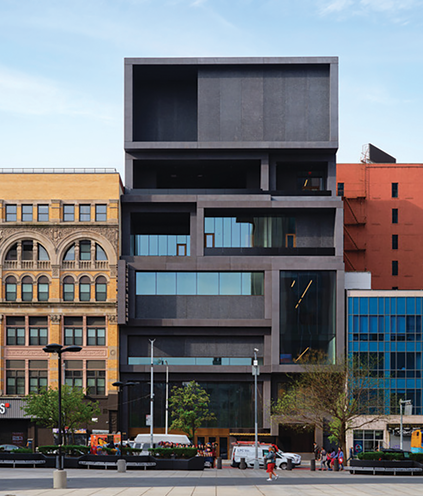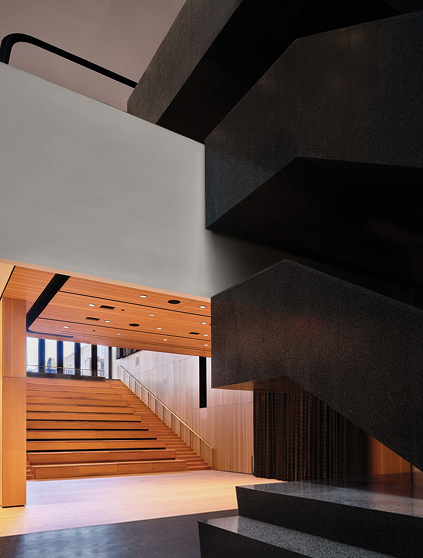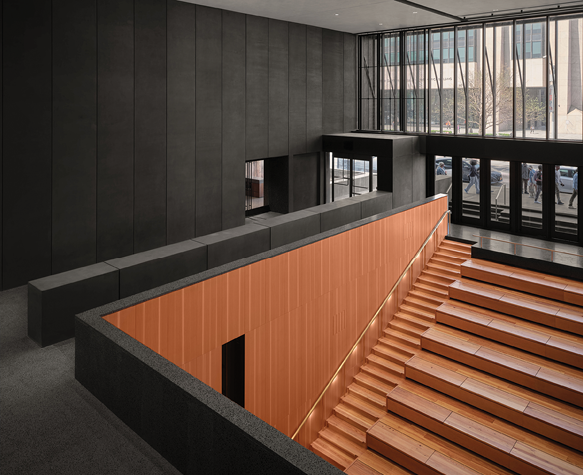- Home
- Media Kit
- MediaJet
- Current Issue
- Past Issues
- Ad Specs-Submission
- Reprints (PDF)
- Photo Specifications (PDF)
- Contact Us
- PRIVACY POLICY
- TERMS OF USE
![]()
ONLINE
![]()
ONLINE

Design And Justice
Editors’ Note
Pascale Sablan, FAIA, NOMAC, LEED AP, is Chief Executive Officer of the Adjaye Associates New York studio overseeing projects in North and South America and the Caribbean. Since joining the firm, Sablan has played a pivotal role in the strategic development of the New York office with particular attention to community-serving projects, community engagement programming, and advocacy initiatives. She has extensive experience in project management and leading design teams on cultural, civic, and commercial projects internationally, and she regularly leads the development of community engagement strategies to uncover cultural narratives and deliver built environments that respond to diverse needs and aspirations. An active voice in the industry, Sablan served as the Immediate Past President of the National Organization of Minority Architects (NOMA), was awarded the 2021 AIA Whitney M. Young Jr. Award for her advocacy efforts, and is a member of the American Institute of Architects College of Fellows. She has given lectures at colleges and universities nationally and globally, including prestigious institutions like the RIBA, Cooper Hewitt, and the United Nations. Sablan holds a bachelor of architecture from Pratt Institute and a master of science in advanced architectural design from Columbia University.
Firm Brief
Adjaye Associates (adjaye.com) strives for an architecture that enriches daily life and meets the diverse needs of the communities it serves from the intimate to the expansive. The firm believes architecture presents opportunities for transformation – materially, conceptually, sociologically – and can act as a catalytic mechanism for bridging and creating relationships between the human body, society, and the world. As a multidisciplinary studio, research is indispensable to Adjaye Associates’ process and it undertakes the responsibility of articulating narratives through understanding the past in order to create a vibrant, socially and environmentally responsible future. Notions of place-making, identity, memory and meaning are central to the firm’s design process as it aims to create structures conducive to positive forms of human transformation.

Adjaye Associates designs (above and below)
Will you discuss your career journey?
My career has been defined by both design excellence and a deep commitment to advocacy. I trained as an architect with a passion for cultural, civic, and institutional projects that not only shape skylines, but also tell the stories of communities. Over the years, I’ve had the privilege of contributing to landmark projects like the African Burial Ground National Monument in downtown Manhattan and the Studio Museum in Harlem, where design became a vehicle for celebrating identity, history, and belonging. Today, I serve as CEO of Adjaye Associates and am responsible for the Americas and the Caribbean, leading projects at the intersection of innovation, culture, and community impact.
At the same time, I’ve always believed that architecture must be more inclusive and representative of the world we serve. That conviction inspired me to establish Beyond the Built Environment, a nonprofit that has elevated the work of more than 1,100 diverse designers through 53 global exhibitions under the banner SAY IT LOUD. My advocacy has grown alongside my practice, creating a feedback loop where leadership in one sphere strengthens the other.
What has guided me throughout is purpose: proving that the profession can be radically more just, diverse, and empowering. Every role I’ve taken on – from serving as President of the National Organization of Minority Architects (NOMA), to representing the American Institute of Architects on the Union Internationale des Architectes’ Professional Practice Commission, to chairing both the NYCxDESIGN Board and Adjaye Associates’ Admin Board – has been in service of opening doors, breaking ceilings, and ensuring the next generation sees themselves reflected in the built environment. My journey has been less about following a straight path and more about insisting that design and justice walk together.
How do you describe Adjaye Associates’ mission?
Adjaye Associates is driven by the belief that architecture has the power to transform lives and strengthen communities. Our mission is rooted in creating designs that are not only visually compelling, but also deeply attuned to context – cultural, historical, social, and environmental. We see each project as an opportunity to tell a story, to honor a place, and to shape spaces that foster connection, equity, and belonging.
The studio is also intentional about pushing the boundaries of innovation. Whether we are working on a museum, a cultural campus, or a neighborhood masterplan, our process is collaborative and multidisciplinary, weaving together art, material research, and community engagement. The result is architecture that feels both contemporary and timeless – rooted in the past yet responsive to the needs of the future.
What excites me most about our mission is its alignment with my own values: to ensure that the built environment reflects the diversity of the people it serves. From Accra to London to New York, our practice is global, but our commitment is always local – listening, learning, and designing in ways that leave communities stronger than we found them.

Will you provide an overview of Adjaye Associates’ approach?
At Adjaye Associates, our approach begins with listening. We invest deeply in understanding the communities, histories, and cultures that shape each project. Rather than imposing a singular style, we develop a design language that is responsive to context – whether that’s a civic landmark, a cultural institution, or a neighborhood intervention. This intentionality allows our work to feel specific, meaningful, and enduring.
Collaboration is at the heart of our process. We engage a wide network of experts – from local architects, engineers, and artists to historians and local stakeholders – to ensure that every perspective is valued and every solution is comprehensive. Our global practice, with studios in Accra, London, and New York, allows us to bring a wealth of experiences to the table while remaining rooted in the unique needs of each place.
We also see design as an evolving conversation between tradition and innovation. Material experimentation, sustainable practices, and community engagement inform every project, resulting in architecture that is not only beautiful, but also socially and environmentally impactful. Ultimately, our approach is about creating spaces that inspire, empower, and endure.
Will you highlight Adjaye Associates’ history in New York?
Adjaye Associates has had a strong presence in New York since its founding with the commission to deliver the Smithsonian National Museum of African American History and Culture, establishing the studio as both a creative hub and a trusted collaborator in shaping the city’s cultural and civic landscape. From early projects like the Sugar Hill Mixed-Use Development in Harlem to transformative cultural commissions such as the Studio Museum in Harlem and the Princeton University Art Museum, our New York work reflects the city’s dynamism, diversity, and global influence.
The New York studio has always been a place where local impact meets international reach. Our projects span a wide spectrum – museums, memorials, performance spaces, educational facilities, and residential communities – each grounded in the belief that architecture should advance equity and cultural expression. The Newton Enslaved Burial Ground Memorial, now under construction, represents one of our most significant contributions: a sacred site and a testament to the power of design to honor untold histories.
Today, as CEO of the New York studio, I am proud to lead a team that reflects the city itself – diverse, visionary, and committed to creating work that matters. Our office continues to engage in projects that not only shape the built environments, but also contribute to global conversations about design, justice, and community.

What are some of Adjaye Associates’ projects in the New York market?
While Adjaye Associates’ practice extends across North America, South America, and the Caribbean, our most significant contributions in New York have helped define the city’s cultural and architectural landscape. The Sugar Hill Mixed-Use Development in Harlem is a model of socially responsive design, combining affordable housing, a children’s museum, and early education classrooms within a striking architectural form. The Studio Museum in Harlem, currently under construction, builds on that legacy, creating a world-class cultural institution rooted in community.
We have also shaped New York’s residential and workplace environments. 130 William, a 66-story residential tower in Lower Manhattan, reimagines the skyscraper through textured hand-cast façades that honor the city’s masonry traditions. The SEIU 1199 Headquarters renovation provided a modern, flexible workplace for one of the largest and most influential labor unions in the United States. And most recently, the Dream Charter School underscores our commitment to education, offering inspiring spaces for the next generation of leaders in New York.
Together, these projects demonstrate the breadth of our practice – from housing and education to culture and workplace – and reflect our mission to design spaces that are both contextually resonant and socially impactful.
What has made architecture so special for you?
For me, architecture is more than buildings – it is a language of memory, culture, and justice. It has the unique power to tell stories, to make the invisible visible, and to transform how people experience their communities. Growing up, I learned quickly that the built environment is not neutral; it reflects the values of those who shape it. That realization gave me both a sense of responsibility and an opportunity: to use design as a tool to celebrate heritage, foster belonging, and create spaces where everyone feels seen.
Architecture is also special because it marries imagination with impact. Few disciplines allow you to dream boldly on paper and then watch those dreams become lived realities that touch people’s daily lives. Every time I see children walk into a school we’ve designed, or communities gather at a memorial we’ve built, I am reminded of the privilege and power of this work.
As a practice, we’ve embraced storytelling as an essential part of architecture – publishing numerous books and essays that extend the life of our projects and ideas beyond the built form. Earlier this year, I contributed to this legacy by publishing GREATNESS: Diverse Designers of Architecture, a book that amplifies the voices and work of women and BIPOC designers globally. For me, architecture is both art and activism, and through building and storytelling alike, I seek to advance equity, representation, and justice in our profession and our communities.
What advice do you offer to young people beginning their careers?
To those just beginning their careers, I always say: trust that your voice matters. Architecture, like many professions, has often been shaped by a narrow set of perspectives, but the future depends on a wider range of voices, experiences, and imaginations. Don’t be afraid to bring your full identity and lived experience into your work – they are not limitations, but superpowers that can transform the field.
I also encourage young professionals to seek out community. No one advances alone. Mentors, peers, and networks can offer guidance, support, and opportunities that will carry you through the inevitable challenges of this path. For me, organizations like NOMA provided a sense of belonging and a platform to lead before I even realized I was ready. Surround yourself with people who believe in you, challenge you, and remind you of your worth.
Finally, give yourself grace. Careers are not straight lines; they are journeys of learning, growth, and sometimes setbacks that prepare you for greater impact. Stay curious, stay persistent, and stay committed to purpose. When you align passion with perseverance, you will not only build a career – you will build a legacy.![]()